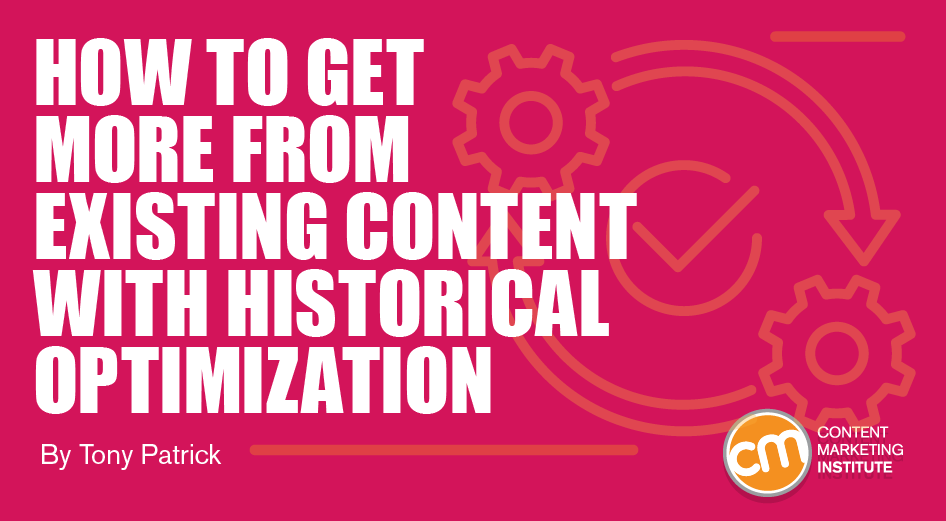 Considering all the ways to draw attention to your content, one underutilized tactic could help you get even more from your creation efforts: historical optimization.
Considering all the ways to draw attention to your content, one underutilized tactic could help you get even more from your creation efforts: historical optimization.
Historical optimization involves updating published content to give it new life and longevity. This powerful tactic taps into everything you’ve already done. All the content painstakingly created for your website can be used again and again to engage readers with up-to-date information, improve search visibility, generate organic traffic, and boost the return on your content marketing investment.
Historical optimization gives published #content a new life and longevity, says Tony Patrick of @InfluenceandCo via @CMIContent. Click To TweetSuccessful historical optimization example
Let’s take a blog post I published in 2014, How to Pitch Your Content to Editors. By 2021, the content was ranking lower in search results, which naturally led to a decrease in organic traffic to the article. People had stopped engaging, and the embedded calls to action were essentially dormant.
We did an overall content audit and realized the site included that 2014 article and two similar blog posts on the topic. (The latter two articles combined netted fewer than 1,000 views, 1 new contact form completed, and no new customers.) Instead of continuing to split traffic across three pages, we consolidated the content into one updated in-depth blog post. We redirected the original URLs for the two similar articles to the updated in-depth blog post URL. We added hyperlinks to other relevant on-site content, infused the piece with updated keywords, optimized our calls to action to be more visible and direct, and added fresh information.
The results? After five months, the updated blog post brought in 7,600 page views and 26 new contacts. It started ranking for highly relevant keywords; moreover, it influenced a sale. We had taken the old content, added minimum new effort, and earned a fresh boost in our most impactful performance indicators.
A historical optimization led to combining three old posts into an in-depth new version that brought big #ContentMarketing results, says Tony Patrick of @InfluenceandCo via @CMIContent. Click To TweetHow to implement historical optimization
Here are a few basic steps to practice historical optimization in your content marketing and squeeze every last drop of ROI from your site’s content:
1. Perform a content audit
You won’t know where to start with historical optimization if you don’t know how your content is already performing. You need to perform a content audit to identify the pockets of potential.
List existing content. Next to each item, note the corresponding engagement data, such as search rankings, CTA click-through rate, organic traffic, bounce rate, etc. You can see which pieces perform well, gaps in topic coverage, and opportunities to cultivate your articles into a content hub.
But don’t just look at your own content. Dive into the top-ranking pages for the keywords you want to rank for. Use these as a guide to what type of information should be in your updated content versions.
HANDPICKED RELATED CONTENT:
2. Select a few pieces to update first
In your content audit, you probably discovered many pieces that could use some optimizing. But try to update everything at once, and you’ll get confused and overwhelmed, and it will be difficult to see which incremental changes move the needle. Start slow and small.
Select one or two articles to jump-start your efforts and your ultimate goals for the content. You could choose a post still gaining traffic and update its language, so readers don’t encounter outdated information. Or you could choose a post ranking in search results that isn’t leading to sustained engagement on your site. Trying to focus on conversion? Choose to update the content that encourages users to download a resource or submit a form and jolt them into taking action.
Select 1 or 2 articles to jump-start your historical optimization efforts. Pick ones that relate to a business goal, says Tony Patrick of @InfluenceandCo via @CMIContent. #ContentMarketing Click To TweetHANDPICKED RELATED CONTENT:
3. Measure pre- and post-update performance
Just like you need to perform an audit to see how your content is doing, you also need to measure the impact of the updates to see whether they’re valuable. Think of it as a scientific experiment. You have a hypothesis about optimizing existing content, but until you see the data difference between old posts and new, you won’t be able to prove your hypothesis.
What happened when you updated the content on the page? Did conversions increase? Did the piece’s level of engagement begin to match its search engine rankings? Be patient. Seeing better results won’t happen overnight.
Set yourself reminders to analyze performance over time so you can understand which tactics are making the biggest impact. For example, you might check incremental progress after one, three, six, and 12 months.
In the graphic below, you can see how we measure the progress of our updated posts based on our results tracked through HubSpot, such as new form submissions, new contacts, page views, etc., and Moz, such as page authority, linking domains, and inbound links. Documenting the metrics on a spreadsheet allows us to monitor the results over time easily. We highlight improved metrics in green and diminished metrics in red.
Historical optimization is a bold but repeatable way to boost your content marketing ROI. Tap into that wealth of content just sitting on your website and take action to engineer more engagement, up your conversions and CTRs, and see tangible progress of your content contributing to your business goals.
HANDPICKED RELATED CONTENT:
Cover image by Joseph Kalinowski/Content Marketing Institute


